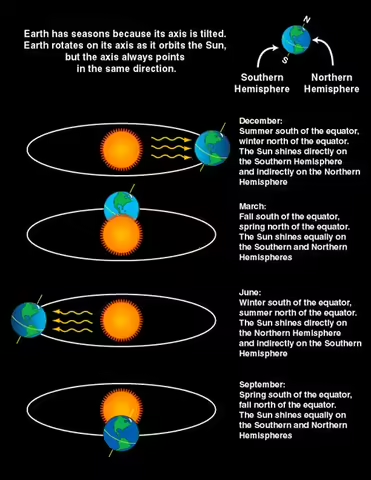
You may have heard weathercasters saying that December 1 is the beginning of meteorological winter. However, the calendar says winter starts on December 21. Why are there two dates?
Meteorological vs Astronomical winter
December 1 is called the beginning of meteorological winter because we often start experiencing what we think of as winter weather by the beginning of that time. The same goes for spring weather by March 1, summer by June 1, and fall by September 1.
Astronomical winter doesn’t start until December 21, sometimes the 22, because of where Earth is in its orbit around the sun.
Orbit, tilt, and seasons
As the Earth moves around the sun, its spin, or rotation, is tilted in relation to the sun. This tilt is 23.5 degrees away from being straight up and down. The tilt remains the same from year to year, so in other words the tilt stays in the same position as earth moves around the sun. Side note, the tilt does change, but it’s over thousands of years.
On December 21, also called the winter solstice, the top half of the Earth is tilted away from sun, while the bottom half is tilted toward the sun. This makes the noontime sun in the northern half of the earth the lowest it will be for the year. Lower noontime sun makes the sun’s energy spread out more and doesn’t heat up the Earth as much. This in turn, makes for generally cooler or cold weather.
If you were to observe the noontime sun in the weeks leading up to December 21, you would see it gets lower in the sky each day. On December 21, the noon sun is the lowest in the sky it will be for the year. On the winter solstice, you would have to be at the Tropic of Capricorn, which is 23.5 degrees south of the equator, to see the sun directly over your head. As you might already know, the southern half of the Earth will be starting its summer season then.
After the winter solstice, the noon sun will slowly go higher until it reaches its highest point in the sky on the June solstice, which is June 21 or 22.
In addition, before December 21, daylight hours continue to decrease about 2 minutes each day in Illinois. After December 21, daylight hours will start to increase.
In a previous blog, I talked about changes in the distance between the earth and the sun, and how those changes only have a minor effect on seasons. In 2023, the earth will be closest to the sun on January 4, and it always occurs around this time. So, while it may make winter a little less harsh, it doesn’t control when seasons occur.
Photo credit: NASA
ABOUT THE BLOG: All About Weather explores the environment, climate, and weather topics for Illinois. Get in-depth information about things your weather app doesn't cover from summer droughts to shifting weather patterns. Never miss a new post! Sign up for our email list.
MEET THE AUTHOR: Duane Friend is the Illinois Master Naturalist Coordinator and Climate Specialist with University of Illinois Extension, serving the organization in many roles since 1993. Duane provides information and educational programs to adult and youth audiences in the areas of soil quality, weather and climate, energy conservation, and disaster preparedness. These programs provide practical solutions for families, farms, and communities. He assists families in creating a household emergency plan, farmers with the implementation of soil management and conservation practices, and local government officials and business owners with energy conservation techniques.
